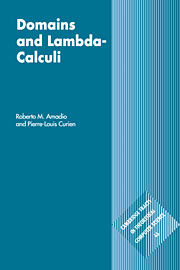Book contents
- Frontmatter
- Contents
- Preface
- Notation
- 1 Continuity and computability
- 2 Syntactic theory of the λ-calculus
- 3 D∞ models and intersection types
- 4 Interpretation of λ-calculi in CCC's
- 5 CCC's of algebraic dcpo's
- 6 The Language PCF
- 7 Domain equations
- 8 Values and computations
- 9 Powerdomains
- 10 Stone duality
- 11 Dependent and second order types
- 12 Stability
- 13 Towards linear logic
- 14 Sequentially
- 15 Domains and realizability
- 16 Functions and processes
- Appendix 1 Summary of recursion theory
- Appendix 2 Summary of category theory
- References and bibliography
- Index
Appendix 1 - Summary of recursion theory
Published online by Cambridge University Press: 05 November 2011
- Frontmatter
- Contents
- Preface
- Notation
- 1 Continuity and computability
- 2 Syntactic theory of the λ-calculus
- 3 D∞ models and intersection types
- 4 Interpretation of λ-calculi in CCC's
- 5 CCC's of algebraic dcpo's
- 6 The Language PCF
- 7 Domain equations
- 8 Values and computations
- 9 Powerdomains
- 10 Stone duality
- 11 Dependent and second order types
- 12 Stability
- 13 Towards linear logic
- 14 Sequentially
- 15 Domains and realizability
- 16 Functions and processes
- Appendix 1 Summary of recursion theory
- Appendix 2 Summary of category theory
- References and bibliography
- Index
Summary
Partial recursive, or computable functions, may be defined in a number of equivalent ways. This is what Church's thesis is about: all definitions of computability turn out to be equivalent. Church's thesis justifies some confidence in ‘semi-formal’ arguments, used to show that a given function is computable. These arguments can be accepted only if at any moment, upon request, the author of the argument is able to fully formalize it in one of the available axiomatizations.
In this summary, functions are always partial, unless otherwise specified.
Partial recursive functions
The most basic way of defining computable functions is by means of computing devices of which Turing machines are the most well known. A given Turing machine defines, for each n, a partial function f : ωn → ω. More mathematical presentations are by means of recursive program schemes, or by means of combinations of basic recursive functions.
Theorem A1.1.1 (Gödel-Kleene)For any n, the set of Turing computable functions from ωn to ω) is the set of partial recursive functions from ωn to ω, where by definition the class of partial recursive (p.r.) functions is the smallest class containing:
: ω → ω defined by 0(x) = 0.
succ : ω → ω (the successor function).
Projections πn,i : ωn → ω defined by πn,i(x1,…,xn) = xi, and closed under the following constructions:
Composition: If f1 : ωm → ω, …, fn : ωm → ω and g : ωn → ω are partial recursive, then g ∘ 〈f1, …, fn〉 : ωm → ω is partial recursive.
[…]
Information
- Type
- Chapter
- Information
- Domains and Lambda-Calculi , pp. 449 - 453Publisher: Cambridge University PressPrint publication year: 1998
